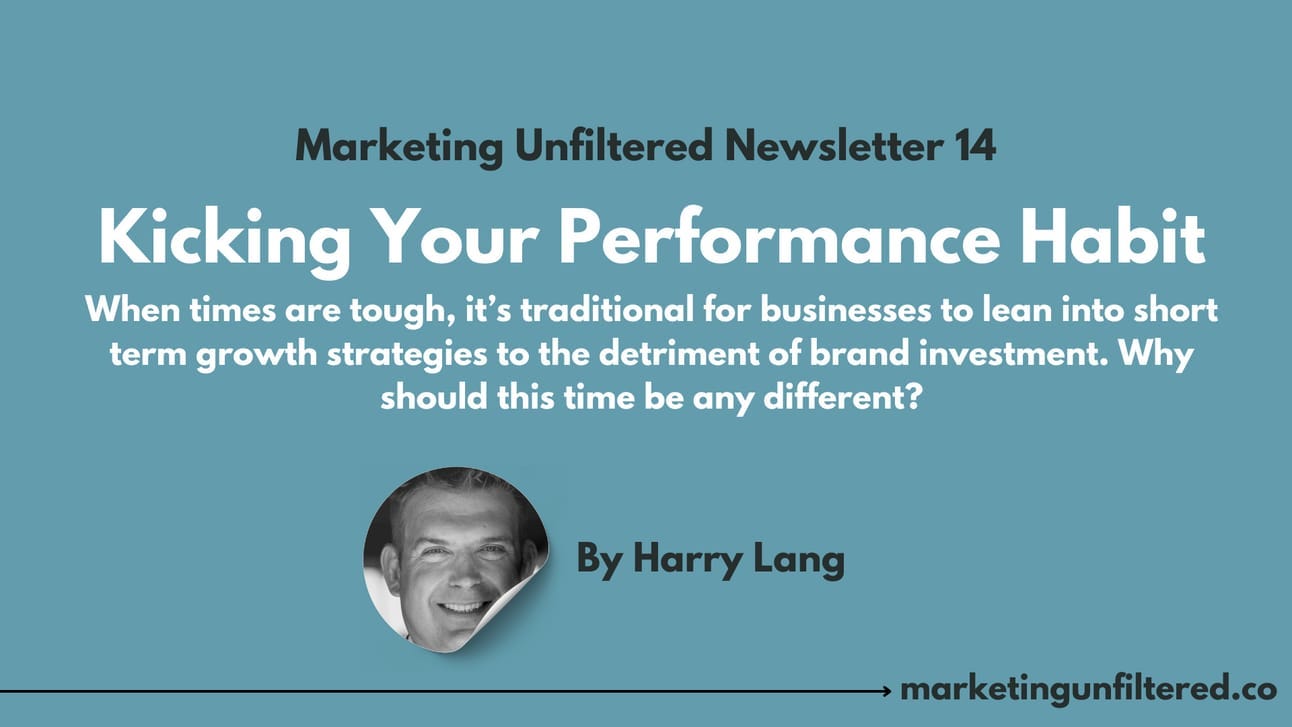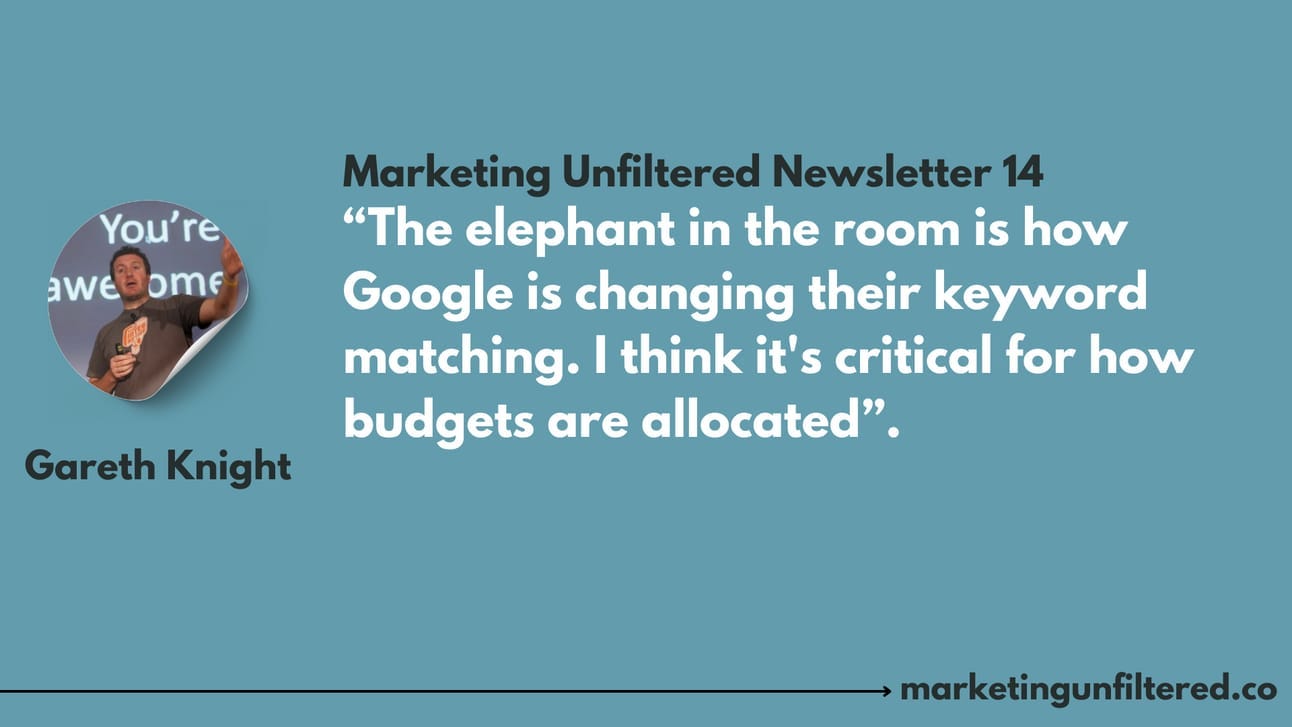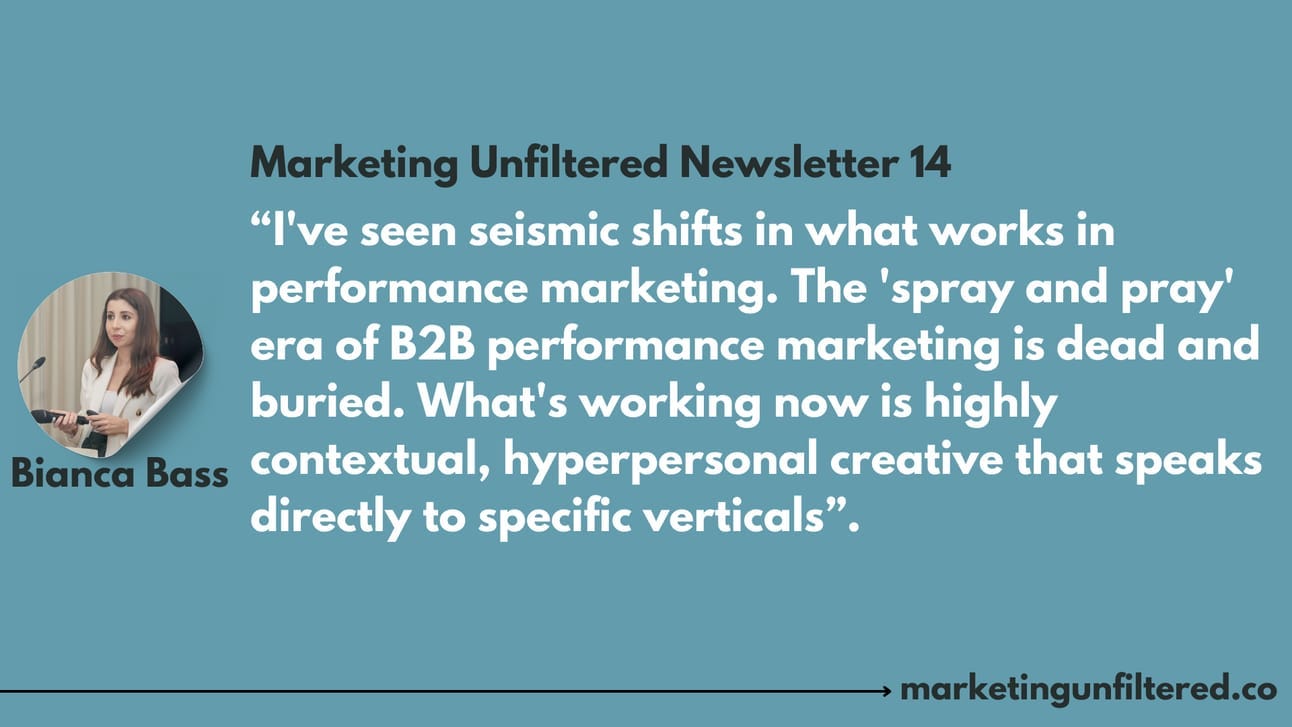Kicking Your Performance Habit
👀 Marketing Unfiltered #14 - Performing Short Term Marketing 👀
Happy Friday Marketing Leaders!
Thanks for making last week’s AI Guide the most popular and most read article so far.
If you missed it definitely read for free prompts, the top tools and best free tools.
This week we have Harry and a number of brilliant Marketing Leaders share their recommendations on all things Performance Marketing.

Kicking Your Performance Habit 💉
When times are tough, it’s traditional for businesses to lean into short term growth strategies to the detriment of brand investment. Why should this time be any different?
This debate has been around since I started my career, and honestly, probably long before that – when things get tough, do you double down on performance marketing and cut back on brand spend or, as I’ve always suspected, is that kind of short-term thinking just setting you up for a fall down the line?
According to the Media Budgets Survey from Ebiquity and the World Federation of Advertisers, 42% of respondents plan to boost their performance marketing budgets in 2025, while only 24% intend to increase brand spend (compared to 21% and 35%, respectively, in 2024). Nothing too shocking here – marketers, especially when faced with anxious CEOs and nervous CFOs, tend to react this way.
However, long-term research says that’s a mistake.
Take the Harvard Business Review’s 2010 report, for example. Their year-long study looked at corporate performance during the last three major global recessions: the 1980 crisis, the 1990 slowdown, and the 2000 bust. They analysed data from 4,700 public companies across three key periods: the three years before a recession, the recession years, and the three years after.
The findings? Well, they won’t come as a surprise to most of you, even if most companies seem to wholeheartedly ignore the bare truth. The companies that managed to balance cost-cutting with investing in their brand were the ones that thrived post-recession. And within that group, there was a smaller subset that made the right mix of defensive and offensive moves—those were the ones with the highest likelihood of success.
“Businesses that continue investing in marketing through a downturn, funded by operational efficiencies, are 37% more likely to come out of the recession stronger than their competitors” concluded the HBR report, reinforced by this 2022 research summary by Analytic Partners:-
“Around 60% of brands that increased media spend in the last recession saw greater ROI. Notably, the brands that spent more, not less, on paid advertising saw a 17% increase in incremental sales”.
Even more surprising, Analytic Partners also found that “...brand messaging significantly outperforms performance messaging, with findings showing that brand messaging drives a higher percentage of customer acquisition and overall sales compared to solely focused performance marketing tactics
Marketing, especially performance marketing, has come a long, long way in the 15 years since that research was published, so do the findings still apply? While brand-building strategies remain largely constant (despite the serious land grab made by social media and influencers), performance is a very different beast now than it was then, with Gareth Knight, Digital Director at Wilderness identifying one significant speed bump, unsurprisingly linked to the ground zero of performance marketing:-
“The elephant in the room is how Google is changing their keyword matching. I think it's critical for how budgets are allocated”.

Increased use of AI for automated bidding, dynamic creative optimisation and predictive analytics can deliver incrementally personalised customer experiences, twinned with a more customer-centric focus, moving the focus away from acquisition and towards longer term advocacy which then leads in turn to increased lifetime value.
Bianca Bass, CMO at Privalgo has embraced these capabilities in how she exploits performance channels to engage with - and entice - B2B customers:-
“I've seen seismic shifts in what works in performance marketing. The 'spray and pray' era of B2B performance marketing is dead and buried. What's working now is highly contextual, hyperpersonal creative that speaks directly to specific verticals”.

Not wanting to blow an already overplayed trumpet, but Les Binet and Peter Field’s findings from their 2019 Brandz report remain highly relevant:-
“Brands that decrease their share of voice in a recession risk suffering a proportional decrease in market share. Meanwhile, strong brands recovered nine times faster”. (BrandZ, 2019).
As ever with any strategic marketing debate, the answer starts and ends with the customer, as the Harvard Business review report concluded:-
“In turbulent times, it’s tough for companies to know where to place their bets for both the immediate term and the long run. Progressive companies stay closely connected to customer needs—a powerful filter through which to make investment decisions”.
As always with these kinds of debates, there’s a massive, galaxy sized caveat that needs to be asterisked:-
We’re all different.
We have different products and different brands at different stages of their evolution in different geos. Sometimes, performance alone is 100% correct, as it was in my last role flogging mobile app games. The success window was too slim and the lifetime ceiling too low to invest in building mini game brands, so hardcore UA performance was the only answer, a case supported by my former colleague Ryan Davies, now Head of Growth at NextBeat:-
“I operate in a 99% digital landscape where performance marketing has become the de facto methodology for growth. Brand marketing pales in comparison to the highly attributable results driven by digital spend across social media platforms and middle-man ad networks like AppLovin (remember this name) and Unity“.
Conversely, in my earlier experiences in online gambling, brand and customer experience were often the only differentiators between multiple operators peddling exactly the same products. We all need to identify our needs and opportunities, be hungry to explore new channels and technologies and find out what works accordingly.
Which brings us, eventually, to the question of why the majority of businesses favour short term performance marketing to the detriment of long term brand investment when things get tricky. It isn’t down to marketers alone, of that I’m certain, having spoken to enough of them over the years. In which case, in some guise, it has to come from above - CEOs and CFOs
Perhaps they’re fiscally incentivised with near term growth targets from boards and shareholders which translates to long term strategic myopia? An inherent misunderstanding of the value of brand as a foundational support for performance marketing? An intrinsic lack of faith in ‘hard to attribute’ brand marketing over data-attuned performance metrics? An inability by us marketers to upwardly educate and influence?
I suspect it’s a little bit of each of them combined to make a soup of misinformation, and as marketers, we’re the ones who need to do a better job of educating and influencing our peers and bosses to rectify this very obvious problem. To do that, we need to embed robust measurement frameworks to demonstrably prove the positive relationship between brand awareness, engagement and reach and the more sales centric performance marketing metrics at the coal face.
To help further that cause, I’d strongly advise any CEO’s and board members reading this to have a quick gander at Interbrand’s most valuable global businesses in 2024 and cross reference that list against the entities that spend the most on brand marketing.
TL;DR - the near absolute overlap isn’t a coincidence…
Harry Lang is Managing Director at Brand Architects, a strategic brand and performance marketing consultancy and author of Brands, Bandwagons & Bullshit, a guidebook about how marketing, advertising, media and PR works. You can connect with Harry on LinkedIn or get in touch at Harry@BrandArchitects.co.uk
For anyone wanting to learn more about brand X performance research and how to plan effective splits between the two across both on and offline brands, then have a read of Effectiveness in Context: A Manual for Brand Building by Les Binet and Peter Field as well as the Kantar Brand equity guide
We will land in your inbox on the 7th of Feb.
Have a great weekend.
Thanks,

